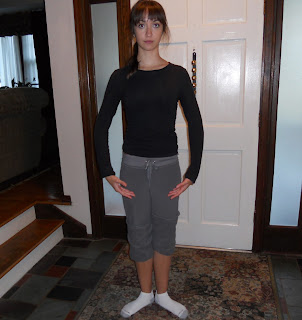Monday, October 18, 2010
Tuesday, October 5, 2010
Phase 1 - Stance/starting position
Externally rotate your hip joint so your feet are turned out, heels together. Keep your arms nice and graceful, close to your body, like your holding a beach ball.
Shoulder Girdle: To start with good posture: Scapulathoracic retraction (adduction) by the rhomboids and the middle and lower fibers of the traps.
Maintain scapulathoracic retraction (adduction) by the rhomboids and the middle and lower fibers of the traps throughout the whole movement.
Shoulder Joint: External Rotation; Adducters hold you there isometrically in a retraction action.
Isometrically contract your rhomboids and your trapezius to maintain good posture throughout movement.
The Elbow and Radioulnar Joints: Flexion of the biceps brachii, brachialis and, brachioradialis muscles. 90 degrees of pronation of the brachioadialis, pronator teres, and the pronator quadratus muscles . Maintain this position isometrically through out the entire movement.
Hip Joint: External rotation of the pectineus, biceps femoris, gluetus maximus, and the 6 deep lateral rotator muscles. Maintain this position isometrically through out movement.
Knee Joint: External rotation of the bicep femoris. Isometrically contract through out movement.
Shoulder Girdle: To start with good posture: Scapulathoracic retraction (adduction) by the rhomboids and the middle and lower fibers of the traps.
Maintain scapulathoracic retraction (adduction) by the rhomboids and the middle and lower fibers of the traps throughout the whole movement.
Shoulder Joint: External Rotation; Adducters hold you there isometrically in a retraction action.
Isometrically contract your rhomboids and your trapezius to maintain good posture throughout movement.
The Elbow and Radioulnar Joints: Flexion of the biceps brachii, brachialis and, brachioradialis muscles. 90 degrees of pronation of the brachioadialis, pronator teres, and the pronator quadratus muscles . Maintain this position isometrically through out the entire movement.
Hip Joint: External rotation of the pectineus, biceps femoris, gluetus maximus, and the 6 deep lateral rotator muscles. Maintain this position isometrically through out movement.
Knee Joint: External rotation of the bicep femoris. Isometrically contract through out movement.
Phase 2- Preparation
Bend your legs at a 45 degree angle keeping your knees in line with your feet. While keeping your arms where they are, you are going to push through your feet and the ball of your feet in order to jump into the air.
Hip Joint: Flexion of the iliacus, psoas major and minor, rectus femoris and sartorius muscles concentrically.
Knee Joint : Flexion of the sartorius, biceps femoris, semitendinosus, semimembranosus, and gracilis concentrically.
Hip Joint: Flexion of the iliacus, psoas major and minor, rectus femoris and sartorius muscles concentrically.
Knee Joint : Flexion of the sartorius, biceps femoris, semitendinosus, semimembranosus, and gracilis concentrically.
Phase 3 -Follow through & Phase 4- Landing
During this split second in the air, point your toes and keep your body as still as possible. (you want to get some good height between your feet and the air).
Hip Joint: Flexion of the iliacus, psoas major and minor, rectus femoris, sartorius, pectineus muscles isometrically isometriclaly. jumping in the air.
Knee Joint: Extension of the rectus femoris, vastus intermedius, vastus lateralis and vastus medalis muscles isometrically while jumping in the air.
Hip Joint: Flexion of the iliacus, psoas major and minor, rectus femoris, sartorius, pectineus muscles isometrically isometriclaly. jumping in the air.
Knee Joint: Extension of the rectus femoris, vastus intermedius, vastus lateralis and vastus medalis muscles isometrically while jumping in the air.
(Phase 4) Landing
The balls of your feet should be the first thing that touches the ground, and gently roll down from the balls of your feet onto your heels. Make sure there is a slight flexion in the knees to ensure a soft landing. Weight should be distributed evenly in the feet so you are not falling forward or backward, and to also prevent injury.
Hip Joint: Flexion of the iliacus, psoas major and minor, rectus femoris, and sartorius muscles eccentrically.
Knee Joint: Flexion of the sartorius, biceps femoris, semitendinosus, semimembranosus, and gracilis eccentrically.
Phase 4- Return
Gently roll down from your ball of your foot to your heels. ( Bend your legs to 45 degrees to catch your jump and land as softly as possible. (should not sound like an elephant). You should not have moved from the spot that you initiated the jump. You should look weightless and effortless.
Subscribe to:
Comments (Atom)




